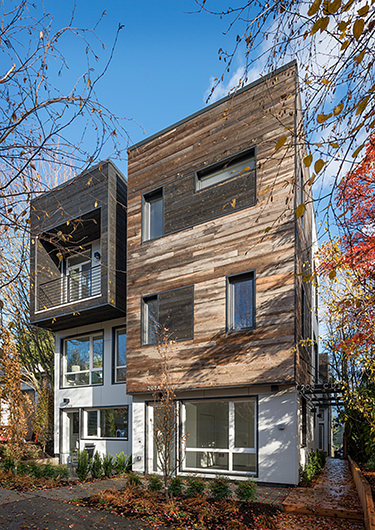|
Subscribe / Renew |
|
|
Contact Us |
|
| ► Subscribe to our Free Weekly Newsletter | |
| home | Welcome, sign in or click here to subscribe. | login |
Environment
| |
 |
February 26, 2015
Six reasons developers should build net-zero apartments
NK Architects

Weyand
|
Would you design your new building to reduce energy use by at least 80 percent if you could maintain an acceptable return on your upfront investment?
We believe that most developers would answer, “Yes!” and have no problem building net zero-ready buildings, provided they could achieve their financial objectives.
The Seattle metro area built 8,600 apartment units in 2014 and has 50 multifamily projects at various stages of construction, and nearly none of them will meet net-zero energy (NZE) or Passive House qualifications.
While this growth is impressive, we’re left wondering: What’s preventing our city from building high-performance apartment buildings?
In fact, the city of Seattle’s Climate Action Plan calls for all-NZE new buildings by 2030 and carbon neutrality by 2050. Considering an average 30-year life cycle of our building infrastructure, we need to be building NZE buildings now to meet these targets. So how can we do this?
Meeting of the minds
To clearly identify the hurdles and industry perceptions, we assembled last fall a group of about 35 local building-industry specialists — developers and contractors, city officials, utility representatives and energy modelers — to discuss how we can work together to radically improve the energy efficiency of new and existing buildings towards the goal of a carbon-neutral city. The group agreed that more NZE-ready development at all scales is immediately needed to stay on track with the city’s Climate Action Plan.
The discussion centered on the real estate pro forma as a mechanism to enable NZE-ready buildings, with the assumption that more such buildings will be created if their pro formas pencil.
There was consensus that compelling pro formas will motivate the construction of more NZE projects, and agreement that more analysis is needed in several areas of NZE-ready project feasibility, including construction cost premiums, buyer/tenant demand, marketability, financing, and incentive opportunities.
What can be done
The following summarizes the group’s six conclusions on what it’s going to take to encourage the industry to build higher-performing, energy-efficient buildings today:
• Clarify construction cost premiums: Lack of trade knowledge and training for building NZE-ready buildings along with uncertainty of cost premiums associated with these buildings are among the top hurdles communicated by developers and builders.
• Get appraising, underwriting and banking on board: A key factor in building high-performance buildings is the upfront capital increase required to cover the higher costs of energy-efficient materials, systems and labor.
Although these capital cost premiums are modest — 5-10 percent of hard costs — underwriters must recognize the total value of high-performance buildings, including lower utility bills, lower vacancy rates, lower turnover, and the preference of businesses, employees and residents to choose the best buildings to live and work in.
Appraisers will need to look to the few local projects achieving this standard of building, including the Bullitt Center, the greenest office building in the world, and Cascade Built’s View Haus 5, a Passive House-constructed townhouse project, as early comps. Banks need to identify what they need (if anything) to raise their debt allowance to offset early NZE-ready construction costs.
• Reward actual energy savings: Increased NZE construction cost premiums of about 5-10 percent means increases in equity and debt. This, in turn, means modest infusions of revenue are needed to bring returns in line with investor expectations.
For example, a $10 million NZE project with $1 million revenue would require approximately $50,000 though annual revenue infusion to achieve the same return on investment as a code-minimum energy project. We believe about half of the needed revenue will come from utility cost savings, and initially the other half should include property tax abatements and utility rebates.
As construction cost premiums decline over time through competition and energy code requirements, and as the total market value of high performance is recognized by the market, these incentives can be rolled back.
• Marketability: Poll after poll tells us that renters and home buyers care more about their own health and living a sustainable life than they do about the technology that makes these possible.
Marketing high-performance homes needs to deemphasize technology in favor of simple messages about quality that speak to people’s real concerns. Why should they care? It’s about better indoor-air quality, a better lifestyle, exciting and cutting-edge homes, great daylighting, a savings on utility bills — all pointing to a better future.
• Bolster energy codes: Today’s building codes, while better than those that allowed homes to be built without any insulation, are antiquated given that we know today how to achieve carbon-neutral buildings. A performance-based code that encourages education and innovation in the industry could help drive the necessary change.
It can be argued that one large code change requiring better energy performance rather than many incremental changes will be less confusing and allow industry to adapt more efficiently. Establishing a new baseline that encourages everyone to learn the same techniques and methods will create demand for the same types of products.
Following in the footsteps of Sam Rashkin, chief architect for the U.S. Department of Energy’s Building Technologies Office, let’s make NZE-ready the future standard of building quality and make buildings that “live better, work better, and last better.”
• It needs to become the new normal: Getting to NZE is currently incremental. To be successful, it will take extra work and elimination of the “it can’t be done” mindset. We have the tools to change direction and make NZE-ready the minimum building standard, but it won’t happen unless we work together, lead the change and ultimately make healthy, high-performance buildings the new normal.
We have an opportunity. The opportunity to welcome new residents to our fast-growing city with high-performance homes that set a benchmark for the future of building and construction everywhere. We have an opportunity to offer a better lifestyle and a better outlook, and we believe the way forward is to create a pro forma that pencils.
Tim Weyand is CEO of NK Architects.
Other Stories:
- Energy tools that could change the game
- Why green building has hit the wall, and what to do about it
- How to make a better business case for going green
- Making the most of your energy model
- Seattle is clamping down on waste from construction and demolition
- How to treat stormwater in urban areas — like Totem Lake
- Goal of Capitol Hill EcoDistrict is to make neighborhood green
- How to convince a realist it makes sense to go green
- How do you measure the value of a green building?
- Federal Center South team focused on results, not ratings



